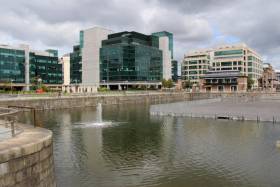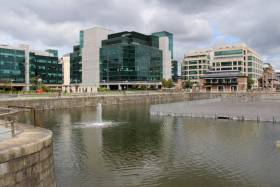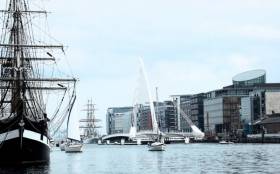Displaying items by tag: Dublin City Council
George’s Dock ‘White Water Rafting Centre’ Plans Now Open For Public Consultation
Plans for a white-water rafting circuit in the heart of Dublin have come back to the fore, as The Irish Times reports.
Earlier this year Dublin City councillors were presented with plans for scheme, which aims to transform George’s Dock in the north inner city into an “elite” white-water canoeing, kayaking and rescue training facility.
Plans stalled before the elections, with former lord mayor Nial Ring branding the White Water Rafting Centre proposals as a “white elephant”.
Changes in the council since this summer’s local elections have now seen the project revived, and it has been opened for public consultation until Thursday 3 October.
But the former lord mayor’s sentiments are echoed by critics who suggest there has been “no consideration” for inner-city youths in the proposals.
Dublin Councillors See Plans For George’s Dock White-Water Course
#GeorgesDock - Dublin City councillors were yesterday presented with plans to transform George’s Dock into an “elite” white-water canoeing amenity for sports and rescue training, according to The Irish Times.
Last April, it was reported that a design tender had been issued for the proposed white-water course and pool as part of the George’s Dock redevelopment.
The rectangular fast-water course would follow the perimeter of the dock basin, with a pool in the centre for flat-water kayaking, water polo and other purposes.
It’s expected that both “elite kayak slalom” squads and emergency services such as the fire brigade would avail of the €12 million facility for training, alongside its potential recreational uses.
Plans also see the former Dublin Docklands Development Authority on Custom House Quay revived as a support building for the white-water course and other water-based activities in the area.
However, Dublin Lord Mayor Nial Ring has described the scheme as a “white elephant”, as other councillors proposed more modest community-based projects for the George’s Dock space.
The Irish Times has more on the story HERE.
Dublin City Council Refloats Idea of Housing Homeless On Cruiseship
#DublinPort - A plan by Dublin City Council (DCC) to house up to 150 people on a rented cruise ship is been considered to help tackle the housing crisis.
The local authority writes The Irish Times, had explored renting a cruise ship from a private operator, to house between 100 and 150 single homeless individuals, before shelving the idea.
In early September, DCC chief executive Owen Keegan told Minister for Housing Eoghan Murphy the plan could be “revisited” to help deal with the ongoing homelessness crisis.
Mr Keegan was responding to letters sent by Mr Murphy to the four Dublin local authorities, setting targets to provide additional homeless family hub accommodation and beds for rough sleepers. The correspondence was released to The Irish Times under the Freedom of Information Act.
For further reading the newspaper reports here, including coverage on up to 10,000 people that took part in the #RaiseTheRoof protest on the housing crisis in Dublin yesterday.
Berthing Licences Join White-Water Course As Part Of Draft ‘Water Animation Strategy’ For Dublin Docklands
#Docklands - The recent design tender for a white-water kayaking course at Dublin’s George’s Dock is part of a wider ‘Water Animation Strategy’ for the city’s Docklands.
Submissions are due this Tuesday 15 May for parties interested in another phase of the draft strategy — this time for vessels of historic or other interest to serve as visitor attractions on the Liffey quays.
Three locations have been identified by Dublin City Council for medium-term lease arrangements, including Custom House Quay at the pontoon immediately east of Sean O’Casey Bridge and immediately west of the Samuel Beckett Bridge, and City Quay immediately east of Memorial Bridge.
Among the proposals welcomed are for historic vessels with an association with the capital or its port; vessels with a community, arts, cultural or leisure purpose to attract visitors; tall ships, including replicas; and ‘visually interesting’ vessels.
Vessels are limited to no more than 50m in length and 7m in height above the water line, excluding masts, funnels, etc. Vessels proposed must be suitable for the location sought, and compatible with existing conditions.
Selections will be made from these expressions of interest for a second stage where applicants “will be invited to enter into competitive dialogue with Dublin City Council for a tender”.
Design Tender For White-Water Course At Dublin City Centre Dock
#GeorgesDock - Dublin City Council has issued a design tender for a white-water course as part of a redevelopment of George’s Dock in the city centre.
According to The Architects’ Journal, the canoeing and kayaking course would be positioned around the edge of George’s Dock at Custom House Quay.
This would surround a swift-water training centre for emergency services, and a proposed public lido, both on an island at its centre.
Currently the dock features a large pontoon for special events held sporadically throughout the year.
The deadline for applications for interested design teams is noon on Wednesday 16 May. The Architects’ Journal has more on the story HERE.
Plan to Dump Tunnelling Waste in Dublin Bay
#DublinBay - A report in this morning's Irish Times says many thousands of tonnes of tunnelling waste could be dumped in Dublin Bay, prompting environmental concerns.
According to the newspaper, Dublin City Council has published notice of a licence application to dump 824,000 tonnes of 'spoil' from the new Ringsend waste water treatment project at a site off Howth Head.
The council says that similar material has been deposited in the past near Burford Bank in centre of the bay, with no harm to the environment.
It also outlined in its licence application how it explored a number of possible alternatives - such as infill for engineering projects - which were eventually ruled out.
Meanwhile, independent councillor Mannix Flynn described the plan as "akin to landfill".
The Curragh Sub Aqua Club has also raised concerns about the potential impact on water visibility and marine wildlife.
The Irish Times has more on the story HERE.
Tall Stories on Jeanie Johnston
Below the Surface is hosting a series of intriguing maritime stories in a unique venue - The Jeanie Johnston, with the atmospheric creaking sounds of the famine ship's hull enveloping the audience as they listen to enthralling tales of Ireland's exciting, seafaring past - from Vikings fleets and their Dublin slave trade to 17th century pirates, 18th century emigration to 19th century polar exploration. All told in a most intimate setting, while the River Liffey gently sways the hull beneath your chair.
These events are celebration of Ireland's maritime heritage and archaeology and generously sponsored by the Department of Arts, Heritage & the Gaeltacht and Dublin City Council
Limited seating, doors open 7.15pm, adm €15
Please see attached flier for additional information.
Booking @ www.jeaniejohnston.ie
DCC Rejects Clontarf Flood Defence Plan
#DUBLIN BAY NEWS - Dublin City Councillors have unanimously rejected controversial plans for flood defences in Clontarf.
As previously reported on Afloat.ie, councillors were set to vote last night on whether to give the green light to the scheme, which has faced strong opposition from local residents and business owners.
The flood barrier would have involved the construction of mounds or walls up to and above 7ft high along the Clontarf promenade.
However, following a vote last night, a redesigned proposal was rejected by the council, with officials admitting to The Irish Times that the public consultation process "didn't work".
Labour councillor Jane Horgan Jones said that it was now up to council officials and the local community to develop an acceptable plan to protect Clontarf from flooding in the future.
"However this is done, it must not be at the cost of destroying a beautiful, free and natural amenity that has been used by generations of Dubliners, from within and outside Clontarf, for many years,” she said.
The Irish Times has more on the story HERE.
DCC Votes Tonight on Clontarf Flood Defences
#DUBLIN BAY NEWS - BreakingNews.ie reports that Dublin City Councillors will vote tonight on whether to give the green light to the controversial flood defence plan for Clontarf.
Thousands of people have held protests in the north Dublin suburb over recent weeks to show their opposition to the plan, which involves mounds or walls up to and above 7ft high, arguing that the council did not allow for any public consultation.
As previously reported on Afloat.ie, the Irish Sailing Association has urged DCC to defer the vote, which has also faced strong opposition from local business owners.
Life Choked Out of North Dublin Fishing Pond
#ANGLING - The public fishing pond at Darndale is "crying out for help" after an infestation of curly weed, The Irish Times reports.
A public meeting to discuss the issue recently heard that the invasive plant has spread throughout the entire pond, making casting all but impossible.
“We have a catchment of some 3,000 youngsters and adults who are deprived of fishing in their locality," said Brian Conneely of Sphere 17 Youth Service. "It’s a sad state of affairs.”
The meeting also heard of a possible solution to the problem, with Dr Joe Caffrey of Inland Fisheries Ireland suggesting a covering of jute or sacking to kill off the weed and allow the growth of native plants - a plan that appears to be working in Lough Corrib.
Costing is the issue, however, with such a jute priced at around €5,000. Maryann Harris of Dublin City Council's parks division said she was exploring grants to fund the project.
The Irish Times has more on the story HERE.






































































